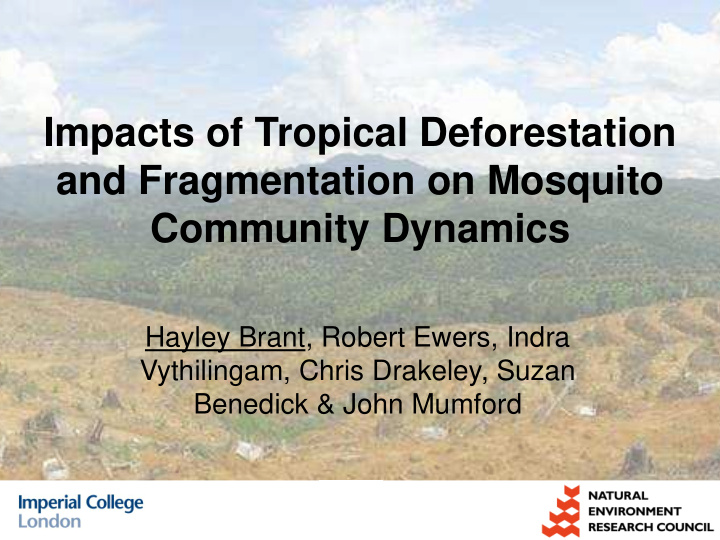



Impacts of Tropical Deforestation and Fragmentation on Mosquito Community Dynamics Hayley Brant, Robert Ewers, Indra Vythilingam, Chris Drakeley, Suzan Benedick & John Mumford
Malaria WHO 2011
Malaria • Five malaria parasites – Plasmodium falciparum – Plasmodium vivax – Plasmodium malariae – Plasmodium ovale – Plasmodium knowlesi • Spread by female Anopheles mosquitoes
Malaria Cases in Sabah William et al. 2013
Plasmodium knowlesi cases in Sabah William et al. 2013
Land Use Change • Land use and land cover changes modify temperature and relative humidity, which can affect mosquito survival, density and distribution • To date, only one study on mosquito abundance in an oil palm plantation within South-east Asia Different stages of Plasmodium vivax (CDC 2013)
Research Question • What is the effect of land use change on: – Abundance – Community composition – Biting times of mosquitoes in Sabah, Malaysia
Old growth forest Logged forest Oil palm plantation
Field site (S.A.F.E. Project) Ewers et al. 2011
Bare leg catches • Human landing catches (5-11pm) • 92 night collections within oil palm plantations, old growth forest and logged forest • To collect anthropogenic crepuscular mosquitoes • Red torch light to seek out mosquitoes
Species collected • 2245 mosquitoes collected • Old growth= 11 species • 7 Anopheles species (83% of catch) • 4 Culicine species • Secondary forest= 31 species • 11 Anopheles species (99% of catch) • 20 Culicine species • Oil palm= 16 species • 8 Anopheles species (86% of catch) • 8 Culicine species
Species collected Old growth Logged Oil palm Species Number % Number % Number % An. balabacensis 13 18.1% 1272 76% 356 71.3% An. Leucosphyrus group 6 8.3% 152 9.1% 9 1.8% An. aitkenii 5 6.9% 70 4.2% 0 0.0% An. macarthuri 1 1.4% 45 2.7% 26 5.2% An. maculatus 0 0.0% 7 0.4% 25 5.0% An. latens 32 44.4% 28 1.7% 2 0.4% Ae. albopictus 0 0.0% 6 0.4% 46 9.2% Cx. quinquefasciatus 0 0.0% 0 0.0% 12 2.4% Arm.jugraneus 4 5.6% 5 0.3% 0 0.0%
Logged Old Am. orbitae An. barbirostris forest growth An. kochi Coq. crassipes Arm. flavus An. aitkenii gr. Cx. bitaeniorhynchus Col. pseudotaeniatus An. watsonii He. scintillans Arm. jugraensis Ma. annulata Pr. ostentatio Orthopodomyia sp. Stg. gardnerii An balabacensis Verrallina sp. An latens Zeugnomyia sp. An. macarthuri An . Leucosphyrus gr. An. vagus An. maculatus An. tessellatus Cx. (Culiciomyia)sp. Cx. gelidus Cx. vishnui Cx.quinquefasciatus Downsiomyia sp. Cx. sitiens Ae. albopictus Oil palm
Biting times ( Anopheles )
Biting times (Culicines)
Conclusions • Large number of mosquitoes in logged forest & oil palm • Each area has a different community composition • Peak biting time 6-8pm for Anopheles in logged forest & oil palm • Anopheles from the Leucosphyrus group were present in all areas
Acknowledgements • John Mumford, Rob Ewers, Chris Drakeley, Indra Vythilingam, Suzan Benedick, Tilly Collins • SAFE Project: Minsheng Khoo, Jonny Larenus, Glen Reynolds, Sarah Watson, Ryan Gray, Unding Jami, my research assistants and other scientists and staff at the SAFE Project • Universiti of Malaya: John Jeffrey, Wong Meng Li • NHM: Ralph Harbach, Theresa Howard, Erica McAlister hayley.brant10@ic.ac.uk • NERC for funding this project, as well as the funders of the SAFE Project • This project was approved by SaBC, IMR, ICREC, MREC, MBMC & SEARPP
Recommend
More recommend